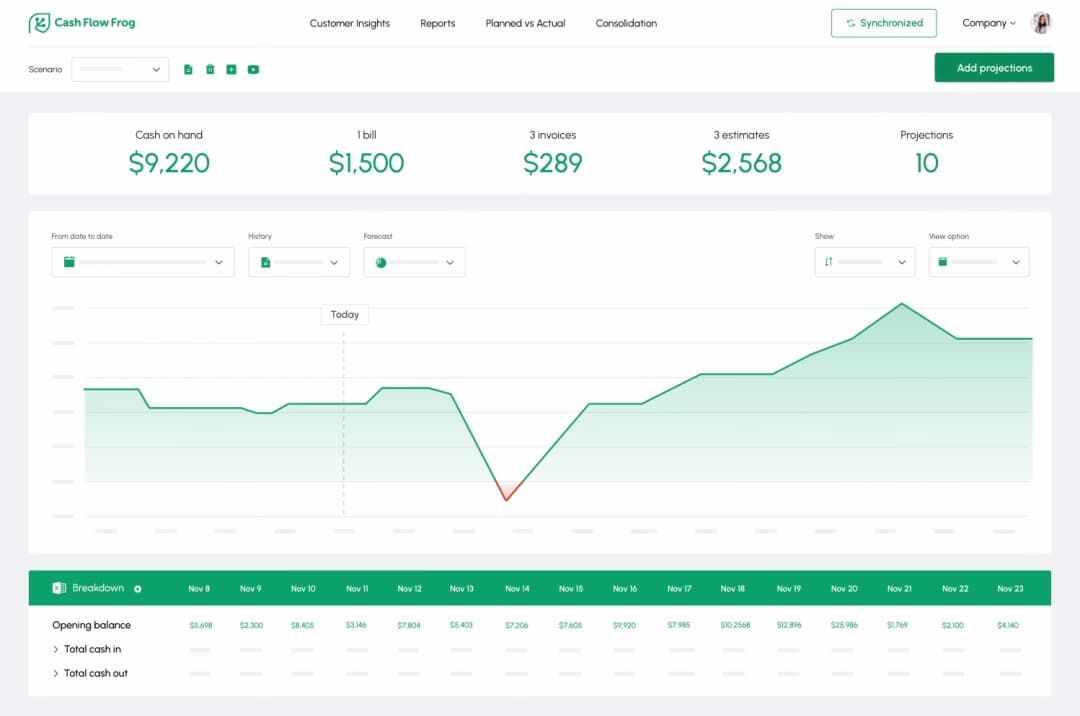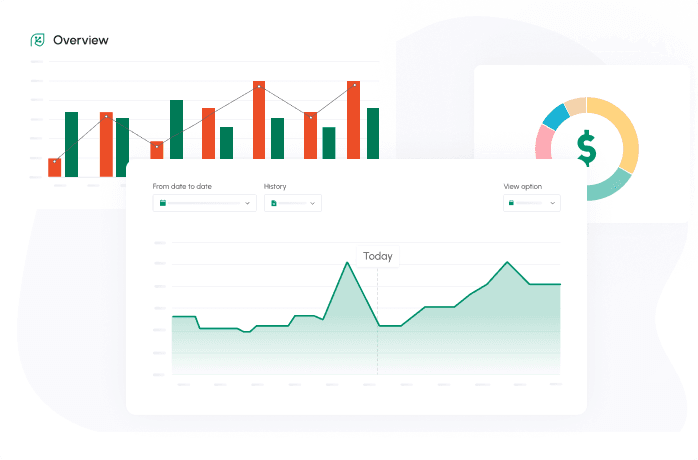Direct Method Cash Flow
Direct Method Cash Flow Explained for Real Businesses
The direct method cash flow is as straightforward as it gets: money in, money out. It enables you to see how your money moves and what’s happening in your business.
For founders, finance leads, and operators, this method of accounting for your cash flows is a great way to make your numbers speak plain English, giving insight into what makes things click.
What Is the Direct Method of Cash Flow?
Direct method cash flow shows you exactly what money came in and what money went out, no accounting gymnastics needed.
Here’s how it works:
- You list cash received (like payments from customers)
- You list cash paid (like salaries, rent, and suppliers)
- That’s it. No need to adjust profit or decode spreadsheets.
With the cash flow statement direct method, you're tracking cash the way you actually experience it, with real numbers, in real time.
It’s simple, clear, and easier to explain than the indirect method. Perfect for anyone who wants to stop guessing and start understanding where their cash really goes.
Direct vs Indirect Method — Core Differences
While the direct and indirect method of cash flow reporting informs you of your total net cash from operating activities, they take different routes in doing so.
Check out below to see how they’re different.
Presentation of Operating Activities
Both methods differ in how they report operating activities in your cash flow statement:
- The direct method tells you exactly what cash came in and what went out. No formulas. No guesswork. Just real numbers you can actually use.
- The indirect method starts with your profit, then works backward with a bunch of adjustments to get to your cash flow. It’s like solving a puzzle you didn’t ask for.
If you want a clear view of your operating cash flow, the kind you can explain to your team in one sentence, the direct method is the way to go.

Cash flow dashboard from Cash Flow Frog | Cash Flow Frog
Treatment of Non‑Cash Items
Not everything on your reports is real money. Here’s how each method handles that:
- The indirect method includes things like depreciation, or items that didn’t touch your bank but still shift the numbers.
- The direct method keeps it simple: if no cash is moved, it’s not on the report.
That’s what makes the direct method cash flow statement format so clear. It sticks to actual money in, money out.
Reconciliation Requirements
Even with the direct method, there’s still some behind-the-scenes cleanup, such as:
- It shows real cash in and out, but you still need to explain how that connects to your profit.
- That’s called reconciliation. Just a quick bridge from net income to operating cash flow.
- The indirect method already includes this by default. With direct, you do it separately.
While the direct method is simpler to read, there's still a little homework under the hood.
Ready to transform your business finances?
Sign upBuilding a Direct Method Cash Flow Statement — Step by Step
Now that you know what is direct method of cash flow statement, it’s time to discover how.
Creating a cash flow statement using the direct method is straightforward. You simply need to account for three key elements.
We’ll explore them below.
Cash Receipts from Customers
Start with the money coming into your business. In a direct method cash flow statement, you only count the cash you actually received. No promises. No invoices. Just real deposits.
Here’s what goes in:
- Payments from customers (not credit sales)
- Bank transfers, POS payments, online checkout, real cash only
It’s the first (and happiest) line in your cash flow statement direct method. Let the real numbers roll.
Cash Payments to Suppliers & Employees
This is the “money out” part of your direct method cash flow.
You’re tracking what you actually paid, no pending bills, no future expenses. Just real cash that left your account.

Paying employees' salaries in cash | Freepik
That includes:
- Team salaries and wages
- Payments to vendors, contractors, and freelancers
- Rent, tools, software, whatever keeps things running
In the cash flow statement format direct method shows what it really costs to operate day to day.
Cash for Interest, Taxes, Operating Expenses
This is all the other stuff your business spends money on to keep running smoothly.
In the direct method of cash flow, you only count what you actually paid, not what you owe later. Include cash spent on:
- Interest on loans or credit cards
- Taxes paid this period
- Everyday stuff like rent, utilities, and software
In your cash flow statement, this is where the quiet-but-crucial expenses show up.
Once you’ve tallied everything, it all rolls up into one clean equation: your direct method cash flow formula:
Cash Flow from Operations = Cash received from customers – Cash paid to suppliers and employees – Cash paid for interest, taxes, and operating expenses
This simple formula is what makes the direct method so clear. You’re just adding up what really happened with your money.
Advantages of the Direct Method
The direct method of cash flow reporting goes beyond simplicity. It gives you clarity and control to make smarter financial decisions. Here’s why it’s worth considering:

Entrepreneur analyzing financial statements | Freepik
- Easy to Read. You see cash in, cash out. That’s it. The cash flow statement direct method feels more like a bank statement than a spreadsheet maze.
- More Real, Less Accounting. No adjusting net income. Just real operating cash flow, straight from your transactions.
- Helps You Act Fast. Need to make a quick decision? This gives you the numbers you need, no digging required.
- Helpful for Stakeholders. Clear, no-nonsense reporting = confident investors, happy lenders, and fewer "Can you explain this again?" questions.
- Built for Better Forecasting. When you know what’s actually happening now, it’s way easier to plan what’s next. Perfect if you care about solid cash flow forecasting.
If you want a clearer picture of your cash for cash flow forecasting, the direct method gives it to you. No filters. No footnotes. Just the real story behind your numbers.
Want to elevate your financial reporting and planning?
See moreChallenges and Trade‑Offs

Entrepreneur preparing a cash flow statement | Freepik
The direct method cash flow has its strengths, but like anything worth doing, it takes a little effort. Here’s what to know before diving in:
- More Hands-On. You’ll need actual payment data, not just net income. Most tools default to the indirect method, so the direct method might require some manual setup.
- Reconciliation Still Needed. Even with clean numbers, you’ll need to link them back to profit for full financial reporting. Just one more step behind the scenes.
- More Team Involvement. This method pulls info from across your business, from finance to ops and sales. If you’re a small team, it can feel like a lot.
- Not Always the Default. Most tools and templates favor the indirect method, so you might have to build or customize your own reports when using the direct method.
This is where cash flow software like Cash Flow Frog helps. It pulls your transaction data automatically, helping you build reports you can use for smarter decisions.
When to Use the Direct Method in Practice
The direct method might look like extra work, but it’s totally worth it in the right situations.
Here’s when you should use it:
1. You Want to Actually Understand Your Cash
If you want to see your operating cash flow without digging through adjustments or reconciling profit, the direct method gives you the straight story.
2. You deal with daily transactions

Daily purchases of customers | Freepik
If money’s always moving, like in retail, SaaS, or services, this method helps you keep up.
3. You Need Better Forecasts
If you’re serious about cash flow forecasting, the quality of your inputs matters. The direct method gives you the cleanest numbers to work with.
4. You Report to Others
Whether it's investors or your team, the direct method cash flow statement format makes your reports easier to follow.
5. You’re growing fast
More decisions, more spending. This gives you the cash clarity to move without second-guessing.
If you want visibility and control over your small business cash flow, the direct method might be your new favorite tool.
Tools & Templates for Direct Method Implementation
The direct method cash flow is simple in theory, but it’s even better with the right tools to back you up. Here’s what can help:
Templates
Skip the blank sheet. A solid cash flow statement template gives you:
- Pre-set categories for inflows and outflows
- A clean cash flow statement using the direct method layout
- Less setup, more clarity
Tools

Cash Flow Reporting Dashboard | Cash Flow Frog
Smart platforms auto-import your data and fill out your direct method cash flow for you. No copy-pasting required.
Look for tools that:
- Sync with your bank and accounting software
- Auto-categorize transactions
- Help with cash flow forecasting, too
A platform like Cash Flow Frog has built-in templates and tools that help you with direct method cash flow reporting, all in one place.
Real‑World Examples & Use Cases
The direct method cash flow isn’t just for textbooks, but for real businesses making real decisions. Take a look at the direct method cash flow examples below:
Example 1: SaaS Startup
- Cash in: $100K in subscriptions
- Cash out: $45K salaries, $10K tools, $5K taxes
- Operating cash flow: $40K
Why it works: The direct method helps founders see exactly what’s coming in from customers and what’s going out to run the business.
Example 2: Retail Shop
- Cash in: $30K in sales
- Cash out: $12K inventory, $6K rent, $2K payroll
- Operating cash flow: $30K – $20K = $10K
Result: By using the direct method cash flow formula, you gain clear, real-time insight into daily cash activity, which is an advantage for budgeting, planning, and forecasting.
Use Cases
The direct method is especially useful for:
- Founders who want a no-fluff view of their money
- Teams managing fast-moving small business cash flow
- Anyone building trust with lenders or investors
- Businesses with lots of cash transactions
These direct method cash flow examples give you a real, no-nonsense view of how your business moves money day in, day out. And that’s what makes it so useful.
Built for accountants and bookkeepers. Check out Cash Flow Frog and lead your clients to success.
See moreBest Practices & Tips for Accuracy

Generating and analyzing the cash flow statement | Freepik
Want your direct method cash flow to stay clean and make sense? Keep these quick tips in your back pocket:
- Track real cash only. No invoices. No IOUs. Just money in and money out.
- Use the right format. The cash flow statement format direct method keeps everything clear. Stick to it.
- Sync, don’t type. Pull data from your bank or tools to avoid errors.
- Reconcile quietly. You’ll still need to tie it to net income for full financial reporting, just do it behind the scenes.
- Keep labels simple. If you have to guess what a category means, it’s too complicated.
- Start with a template. Don’t build from scratch every time. Use tools that make it easy.
A little structure goes a long way. Get these basics right, and your direct method cash flow becomes one of the easiest reports to trust.
Related Terms
FAQ
Looking for more help?
Visit our help center to find answers to your questions about CashFlowFrog.
Trusted by thousands of business owners
Start Free Trial Now